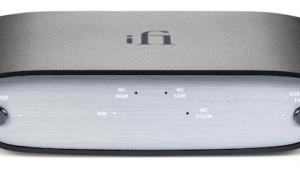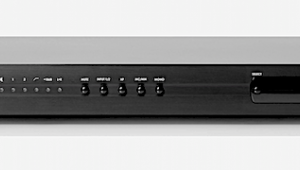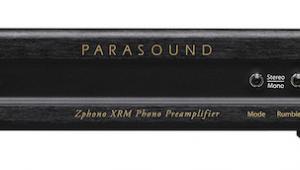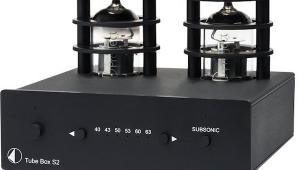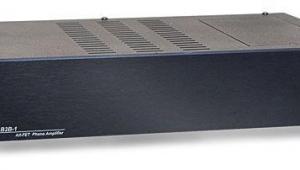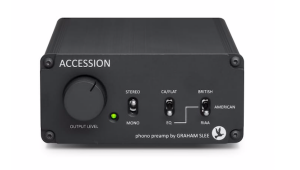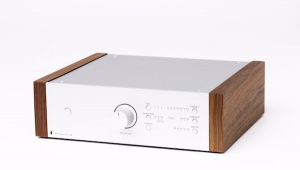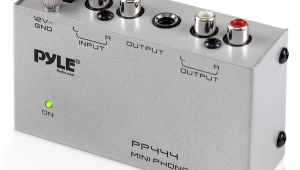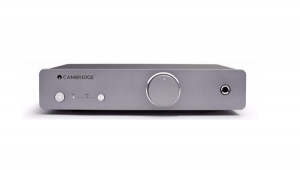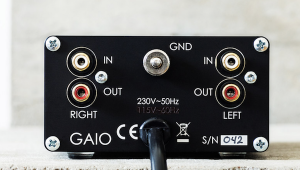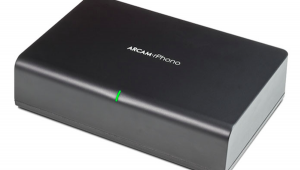iFi's iPhono 3 MM/MC Phono Preamplifier Takes A Giant Sonic Leap Forward

iFi introduced in 2016 the seriously upgraded iPhono2 more positively reviewed on this website. The company made significant upgrades to both parts and features. Despite the many improvements, the price increased a scant $100 to $499.
Among the enhancements were an increase of 12dBs of gain to 72dBs, a dynamic range increase from 90dB to 106dB and a newly designed and improved RIAA circuit spec’d at ±0.2dB accurate from 20Hz-20kHz., new Burr-Brown J-FET amp used in the output buffer and enhanced power supply filtering. An all-new Direct-Drive Servo-less ‘DC Infinity’ circuit replaced the original’s sound degrading coupling caps. The iphono 2 represented a major upgrade.
The new iPhono 3 Black Label, housed in the same chassis as previous versions, is more about enhancements to previously developed circuitry than new ones.
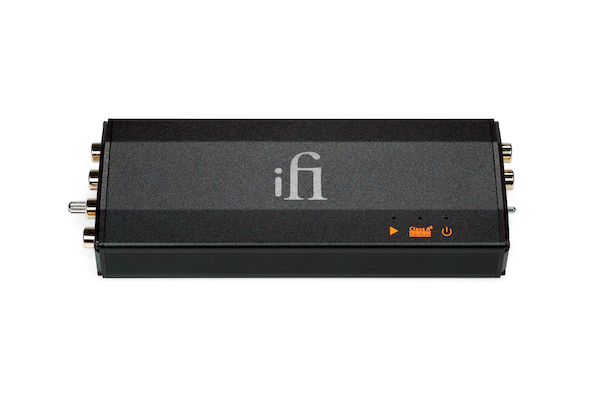
The TubeState solid-state engine developed by Technical Director Thorsten Loesch (also responsible for sister company Abbington Research’s AMR line of hybrid tube-solid state electronics and the $11,995 PH-77 all-tube phono preamp featuring 23 equalization curves and a built-in A/D converter) is here in its third generation.
The iPhono 3 retains the multiplicity of EQ curves (6 in all: RIAA, IEC, Decca and Columbia along with the “enhanced eRIAA” and “enhanced eRIAA+IEC”). “Enhanced” is often referred to as the “Neumann ultrasonic time constant”, which is the iPhono 3’s default out of the box EQ setting.
I suggest immediately setting the EQ to standard RIAA and if you want to know why, and you are technically adept and mathematically savvy, please read Keith Howard’s “Cut and Thrust: RIAA LP Equalization” published online in Stereophile. Even if the math and/or tech proves too difficult to grasp, the reasons to revert to standard RIAA might become clear. More about EQ later.
Despite its small size, thanks to surface mount technology (SMT), the designer manages to stuff a lot of high quality, hand-matched parts onto a single circuit board that have been further improved compared to what was on the iPhono 2 board including: Burr-Brown SoundPlus op-amps, complemented by Panasonic ECPU film capacitors, claimed to deliver “vanishingly low distortion” and ensure excellent dynamic range. Also onboard is a computer-matched pair of planar high-gain bipolar input transistors that lower output noise.
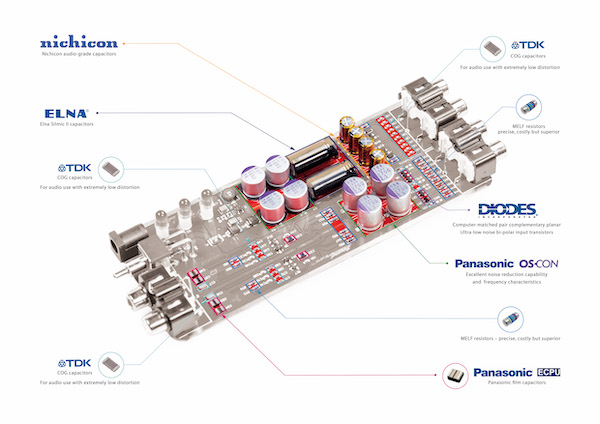
Also new in the iPhono 3 are four Nichicon 470uF/6.3V capacitors that deliver lower ESR (Equivalent Series Resistance, which you will have to research online if you are interested in knowing and understanding what that is) said to improve “speed” and especially bass performance. Eight Panasonic OS-CON capacitors totaling 14,800uF deliver low ESR, excellent noise reduction and exemplary frequency characteristics. Also: Numerous TDK C0G type capacitors – these have lower thermal drift and distortion than Polystyrene capacitors—two Elna Silmic II capacitors for the power supply – these use silk fiber paper for the isolating barrier, resulting in decreased odd-order distortion and reduced microphonics and numerous Vishay MELF thin film resistors, claimed to deliver dramatically reduced distortion compared to standard surface-mounted resistors. Whew! iFi claims for the i phono 3 108dB dynamic range up 5dB from the 2’s already excellent dynamic range spec.
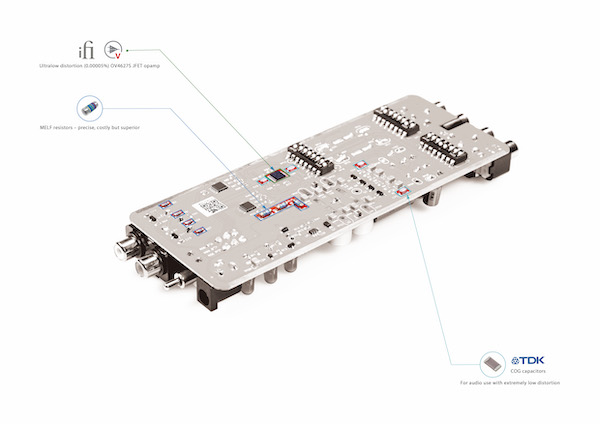
The iPhono 3 Black Label also comes with the 15V version of iFi’s new iPower X ultra-low noise AC/DC power supply that’s sold separately for $100 and can be used to upgrade other iFi products that come with the lesser power supply.
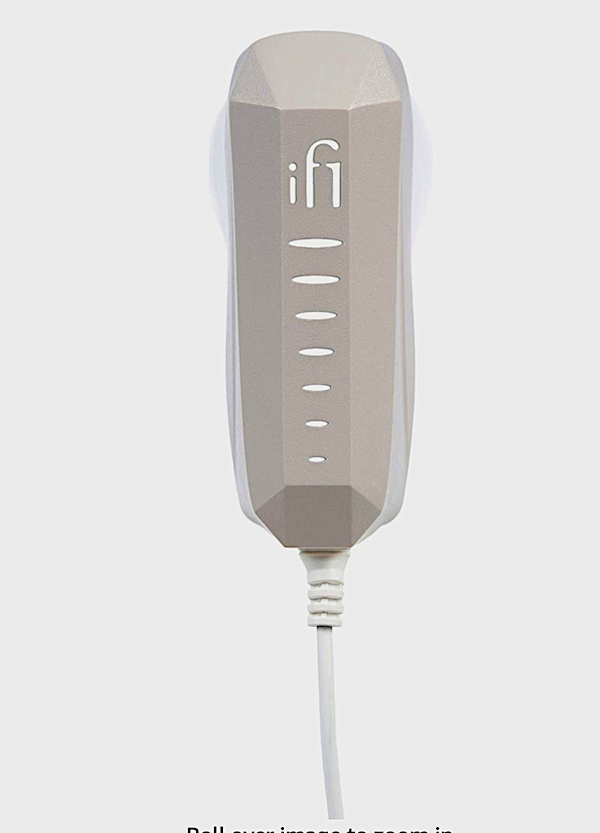
The upgraded power supply includes Active Noise Cancellation2 claimed to cancel all incoming EMI or RFI noise, actuated using technology similar to noise cancelling headphones. Claimed noise floor reduction is >40dB (>100x). Other improvements in the iPower X power supply compared to the standard “wal-wart” include 50% greater input capacitance and 150% greater output capacitance resulting the company says in more filtration and improved dynamics. Solid organic capacitors for better high frequency noise suppression round out the improvements that produce 20% more power. Plus, it’s got to be the coolest looking wal-wart ever. BTW: it can be used with just about any D.C. powered device because it’s available in a variety of voltages (5V, 9V, 12V, or 15V) so your Pro-Ject turntable, among other wal-wart powered products might benefit.
Still Full-Featured
In addition to the 6 EQ curve options MC loading options are 22, 33, 75,100, 250, 330, 1K, and 47kOhms. Capacitance for MM can be set for 100, 200, 300, 400 and 500pF. Gain can be adjusted for 36,48, 60 and 72dB. In other words, despite its impossibly small size, the iPhone 3 is fully configurable.
Same Tricky Dip Switch Set-up
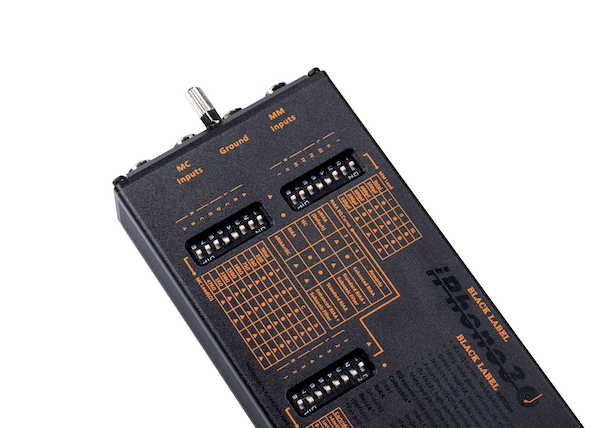
Packing all of that adjustability into such a small package required some incredibly deft circuit design so looking at the unit’s bottom shows that correct set-up requires concentration, perhaps a magnifying glass and carefully following the arrows, while not making any assumptions about what’s where! Fortunately iFi supplies a small plastic dip switch flipper.

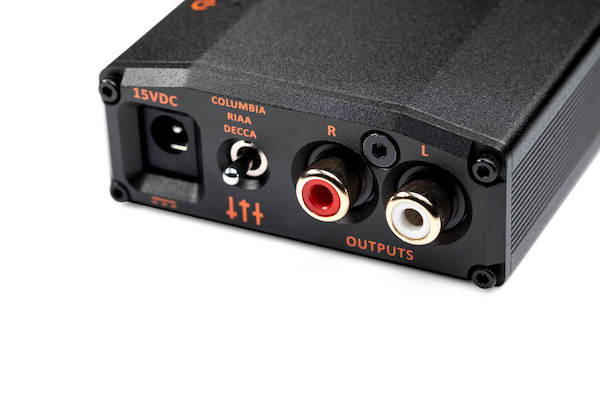
The input and output RCA jacks are closely spaced so large barreled RCA plugs need not apply, but Eichmann “Bullet Plugs” fit fine. iFi supplies useful accessories including a set of RCA interconnects, a ground extension wire terminated with a banana jack and most interestingly a “dummy” IEC A.C. jack in case you encounter ground hum. If you do, plug an IEC A.C. cable into it and the other end into the wall (in the same circuit as the rest of your system). That way you’ll have a path to ground but of course no voltage will come back the other way.
I Fell Through the Noise Floor And, I Can’t Get Up!
Noise floor goes down, price goes up. The iPhono 3 now costs $999 including the upgraded power supply, so think of it as $899 or up $400 in four years from the iPhono 2’s cost.
However since the iFi folks left me the two previous models I was able to fire them up and compare, though I really didn’t need to do that because the iPhono 3 is so clearly and obviously far superior to the original and even compared to the iPhono 2. Feel free to think of the iPhono 3 and costing twice the price of the previous mode. It’s not an issue because if you own an iPhono 2 and upgrade to the 3, you will not regret doing so! It’s that much better.
At first, I ran the iPhono 3 in MM mode on the Schiit Sol turntable currently under review. Schiit was kind enough to include a pair of ready to “drop and play” arms, one fitted with a Grado Opus3 ($275) and the other with an Audio-Technica AT-VM95EN. The iPhono 3 certainly let the cartridge differences clearly express themselves. The Audio-Technica produced a lean, clean, effervescent timbral picture with sharply but cleanly drawn high frequency transients and plenty of air but it didn’t sound at all bright, hard or strident.
The soundstage was huge on Muddy Waters Folk Singer: exceptionally wide and notably deep. I didn’t have to measure separation to know the cartridge would produce excellent numbers. Instrumental attack was supple, clean and not at all overly sharp or aggressive, which is the usual trademark of less costly phono preamps. It made for an exciting Muddy performance. Willie Dixon’s bass was not as robust on bottom as I’m used to but was it the cartridge? The turntable? The iPhono 3? No point in speculating. The overall presentation was extremely engaging, with Clifton James’ sparkling drum kit lighting up the stage free of transient artifacts. It was clean.
When I switched to the Grado it was as if the iPhono 3 left no identifiable “residue” of its own. Now the sonic picture was “Grado-like”, which means richer, warmer and fuller, with added body and weight behind the transient attack, which was somewhat appropriately somewhat more subdued but still lively and super clean. In other words, the iPhono 3 steps aside and lets through the transducer’s flavors.
However, I think most I phono 3 buyers will be using it with a low output moving coil cartridge. Why spent extra for the MC capabilities if you are using an MM when you can get an one optimized for MM like the Lejonklou Gaio 2 or one from Graham Slee?
I have in for Stereophile review a $4995 Aidas Audio Gala Gold LE moving coil cartridge. It’s a super low output (.26mV) cartridge with gold coils and a low internal impedance of 2.7 ohms. It was set up on the Kuzma 4PT so after having broken it in for at least 50 hours as recommended by the manufacturer (sometimes manufacturers [not this one] recommend long break-ins and after a short time wonder where the review is!) I chose to use it with the iPhono 3 rather than the twice as costly cartridge installed on the SAT arm.
The first two Verve audiophile titles arrived, produced in association with Chad Kassem (Getz/Gilberto and Louis Armstrong Meets Oscar Peterson. The bossa nova classic is sourced from metal parts derived from the late George Marino’s cut at Sterling Sound. And why not? It was a good cut when the tape was years fresher. The Louis was cut recently by Ryan K. Smith at Sterling Sound Nashville.
Even with a .26mV cartridge the iPhono 3’s black background was notable. I’d been auditioning the Gala Gold LE using the CH Precision P1/X1 ($50,000+) so was expecting a big letdown but I didn’t get one! The iPhono 3’s portrayal of Milton Banana’s delicate cymbal work, purposely pushed to the background by engineer Phil Ramone on Getz/Gilberto possessed a surprisingly precise transient delicacy coupled with full extension not often heard at the $1000 price point. It took me by surprise.
The iPhono 3’s bottom octave performance was equally surprising (I mean I was really surprised!). Again the delicacy, transient naturalness and extension produced by Tommy Williams’ (uncredited) double bass also pushed subtly back in the mix far surpassed that of the iPhono 2 and as well as my expectations.
Ryan K. Smith cut at Sterling Sound, Nashville the Louis and Oscar album recorded in stereo in 1957 and released in stereo in 1959. Despite a couple of spots were Louis overloads the microphone producing some nasty distortion that’s on the tape, the sound is honest, direct and enjoyable with with Oscar joined by Ray Brown, Louis Bellson and Herb Ellis all in fine form on program of standards.
Louis is directly on an unforgiving microphone with no reverb or anything to soften his voice or the horn. He’s “right there” with no added edginess. Bellson’s drum kit in the right channel is mixed down but low level detail in part thanks to the low noise produced plenty of cymbal sizzle and remarkable transient detail. The iPhono’s rendering of Bellson’s brushwork was smooth, well-detailed, artifact-free and sophisticated sounding. “Remarkable” at any price. I’m not overstating it. Ray Brown’s bass is also down in level center channel, but it too has impressive extension and nimble transient expression. I’m listening now and looking over at this little black box in complete wonderment.
Among the other records I paid careful attention to was a Hungaroton double LP set Kodaly Piano Music Complete (Hungaroton SLPX 11913-14) performed by the late Kornel Zempleni, Hollywood Screen Classics (Chesky CR71) a compilation drawn from the great RCA film score series produced by Charles Gerhardt and engineered by Kenneth Wilkinson at Walthamstow Town Hall and another Chasing the Dragon Direct-to-Disc record, A Day in the Life (VALDC013) featuring trumpeter Quentin Collins All Star Quintet, which does not perform The Beatles’ classic.
Looking for macrodynamics from the Direct-to-disc, I got them. Timbral and spatial performance from the Walthamstow Town Hall venue was as you’d expect from a far more costly and sophisticated phono preamp and the rendering of the solo piano recording exceeded every expectation in terms of instrumental attack, sustain and decay as notes trailed off into the black not often heard from any similarly priced phono preamp that I’m aware of.
Rather than fully repeat what I’ve previously written about the equalization options available here and why I believe the instructions offered by iFi are misguided, I urge you to read the previous reviews.
I’ll just write this: I spoke with George Bettyes one of Decca’s remaining living mastering engineers who assured me that Decca adopted the RIAA equalization curve at the dawn of the stereo era, period. I also spoke with a Columbia veteran engineer who assured me likewise and wondered whether those who suggest otherwise were “on crack”—especially since Columbia farmed out a great deal of work as the LP’s popularity accelerated in the mid ‘60s.
I can’t speak about DGG and Eastern European labels so I won’t. In any case, when playing stereo records 99% of the time the RIAA curve will be correct. Others can be used as “tone controls” but not as technical correctives. That’s my assertion and I’m sticking with it!
Conclusion
IFi’s iPhono 3 is a major achievement in phono preamplification in terms of its adjustability, high gain and low distortion and low noise. If you own an iPhono 2 and love it, sell it and buy an iPhono 3. It’s that much better. The improvement isn’t incremental. It’s a major step forward.
Under the previous reviews readers asked how the iPhono 2 compared to other products at a similar price point. This gets too difficult for a reviewer to cover. There are many choices at around $1000 including some reviewed on this site, but comparing all of them is nearly impossible so I’m not going to compare this one to any of those.
I’ll just conclude by writing that if you’ve got $1000 to spend on a fully adjustable, compact, MM/MC phono preamplifier I don’t see how you can possibly buy an iPhono 3 and regret your decision. The low noise floor alone makes it an exceptional product. Add the low distortion, the exacting transient response and the unit’s superb ability to delineate subtle microdynamic gradations, plus its impressive transparency and you can complete the sentence.
Specifications:
F. Response: 10Hz-100KHz (±.3dB)
Dyn. Range: MM: (36dB):>108dB (A-weighted)
MC: (60dB:>106dB (A-Weighted)
S/N ratio: MM(36db):>85dB (A-weighted re: 5mV)
MC:(60dB):>85dB (A-weighted re. 0.5mV)
Overload Margin:MM (36dB):>26dB (re. 5mV,@ 1%THD)
MC:(60db):>22dB (re.05mV@1%THD)
Crosstalk: <-71dB(1KHz)
Max undistorted output: 7V (Load>=600 Ohm, THD<=1%)
THD: <0.005% (MM36dB 1V out 600R Load)
Output Impedance: <100ohms
Dimensions: 6.2”x2.3”x1.1”/158mm x 58 x 28 mm
Weight: 0.58lbs/265g





